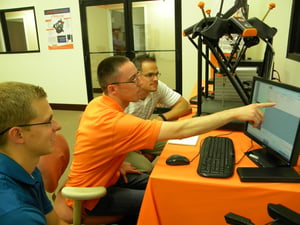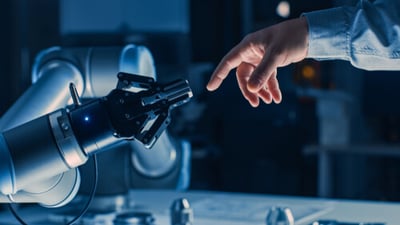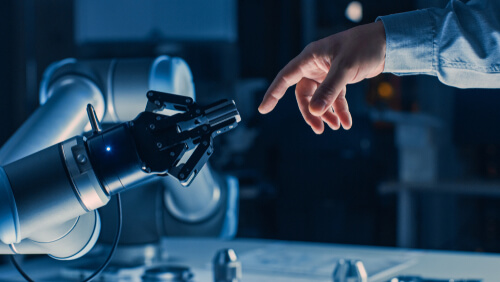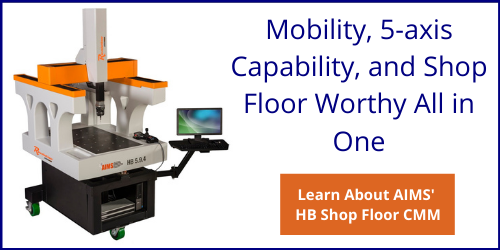CMM Automation Guide: How to Gain Efficiency & Ease the Skill Shortage
In manufacturing, applications for automation and robotics often focus on repeatable manual tasks that can be reliably performed without direct human action. They make processes faster and less prone to human error. In the realm of CMM inspection, robots and ancillary automation equipment are a great way to streamline operations and make up for skill and labor shortages.
Table of Contents
Labor and Skill Shortages
A skills gap has plagued manufacturing for several years and isn’t showing signs of letting up. Companies caught in this gap know how hard it is to find people with skills they need when they need them. There are a number of reasons this is happening:
- A large generation of Baby Boomers once made up a massive workforce, but now are retiring and leaving a massive hole
- Smaller generations of younger workers are less interested in manufacturing and manual labor and are unable (and sometimes unwilling) to take retirees’ places
- When too much time passes without jobs being filled, old and new generations of workers’ paths don’t cross, meaning there’s less opportunity to interact and transfer knowledge
Workers who use CMM equipment need specialized skills. They might also require training to learn how to calibrate the machine and probes, how to operate it, what to do with the readings, how to make adjustments to the CNC equipment, how to know if readings might be inaccurate, cleaning procedures, and more.
 In a perfect world, new hires come to your organization with metrology equipment experience. In reality, you might end up with workers who have never used a CMM closely or at all. If your budget or production schedule doesn’t allow you to send entire teams for training, you might have to select one or two, who then must train the rest when they’re finished. This takes time and may not give everyone enough opportunity to practice.
In a perfect world, new hires come to your organization with metrology equipment experience. In reality, you might end up with workers who have never used a CMM closely or at all. If your budget or production schedule doesn’t allow you to send entire teams for training, you might have to select one or two, who then must train the rest when they’re finished. This takes time and may not give everyone enough opportunity to practice.
In daily operations, operators pick up tips and tricks over time to make the work flow better or to anticipate problems. It’s harder to share this kind of knowledge because some things won’t get taught until the situation comes up.
Automation has been used to ease skill and labor gaps in industries like automotive and medical device manufacturing, warehousing and logistics, and more. There are endless ways to program and configure robots and ancillary equipment to complete or assist with work that was previously manual. As a result, it’s possible to maintain or increase production even at times when workers are scarce.
But did you know that CMM measurement and inspection is one area that can benefit from automation? Shop floor measurement equipment coupled with automation technology is not only possible, it’s already here helping companies get ahead in challenging times.
Why is CMM Inspection a Good Candidate for Automation?
Great skill and experience are required for selecting the right tactile or noncontact probe, selecting measurement points, gathering reference data, and determining critical features. But much of the actual measurement work is repetitive, relatively simple, and (unfortunately) time consuming. It can become a source of production bottlenecks and human error, especially toward the end of a shift when workers are tired.
Robotics and automation excel at tasks like this. Sophisticated CMM software can be programmed with the exact steps for a range of positioning, gauging, and measurements. This means measurements are taken the same way every time, increasing accuracy and reliability.
The CMM can also be integrated with CNC and other machines for real-time monitoring and correction for errors, tool condition monitoring, and other parameters that impact part tolerances.
Today’s automation equipment is highly flexible thanks to intuitive software and programmable logic controllers. It’s possible to set up one machine to do multiple tasks and switch between them with a simple graphical user interface (GUI). An experienced CMM OEM, like AIMS Metrology, can review part prints and cell layouts and recommend the correct CMM solution with fixtures (if required). Fixtures are easy to switch out and can even incorporate a barcode reader that triggers an automated changeover so that each part is always positioned and measured correctly.
 For example, a collaborative robot arm (or cobot) can be used to switch out and calibrate inspection gauges. First, it pulls the correct gauge from a tool change rack and holds it under a scanner to verify that it's the correct one. Then it passes the gauge under a blower to remove any dust. Next, it is automatically clamped in place while an operator calls up the associated measurement program with the GUI on a touchpad. Calibration is automatic, and measurement begins. Once the process is finished, the same cobot grips the gauge, removes it, and returns it to the correct place in the tool change rack.
For example, a collaborative robot arm (or cobot) can be used to switch out and calibrate inspection gauges. First, it pulls the correct gauge from a tool change rack and holds it under a scanner to verify that it's the correct one. Then it passes the gauge under a blower to remove any dust. Next, it is automatically clamped in place while an operator calls up the associated measurement program with the GUI on a touchpad. Calibration is automatic, and measurement begins. Once the process is finished, the same cobot grips the gauge, removes it, and returns it to the correct place in the tool change rack.
Shop-hardened CMMs Bring Measurement to the Point-of-Need
The beauty of modern robots and automation equipment is their ability to assist with measurement right at the point of need, right in the middle of the action. When the CMM is in a traditional lab setting, the operator goes through several steps:
- Make the part
- Stop work to take it to the lab
- Calibrate the machine and take measurements
- Review the results
- Adjust the cutting or other tool to rework or make a new part
- Stop and go back to the lab again
The process is repeated until it’s within tolerance. That’s a large amount of travel time and waiting that adds up to considerable time spent not making parts. While there will always be some adjustments and rework, automation speeds up the process by bringing measurement to the operator.
Outside the controlled environment of the quality lab, a shop-hardened CMM combined with automation equipment makes fast adjustments possible right on the shop floor where it matters most. Typical shop-hardening features include:
- Mechanical linear guides instead of air bearings
- Temperature compensation capability
- Compact size even with large volume capacity
- Ability to switch between tactile and noncontact measurement without dismantling
How Robots and Automation Aid CMM Inspection
While the details of the CMM process vary depending on the manufacturing process, the steps often include moving the part or assembly to the machine, running measurements, removing the part and sending it to the next workstation or placing it in a holding bin.
These common robot capabilities are used to accomplish most of the above tasks:
- Pick and place. Select the part, pick it up, and move it to the inspection area
- Workholding. Holding a part in place while an operator performs a task or prepares the part for measurement
- Machine tending. Monitor the status of the measurement process and automatically adjust or remove the part, or swap out tooling based on a program
- Positioning. Hold the part in the correct position
- Tool changeover. Retrieve the correct tool from a change rack, grasp and install or remove tooling, and replace the tool in the rack
When we think of automation, we often picture a robotic arm. But for CMM work, a collaborative robot (or cobot) is just the starting point.
Cobots are a great option for processes that require human workers to be nearby, such as measurement. In contrast to massive industrial robots that operate in cages at high speeds, cobots have built-in features that make them safe for humans to be nearby during operation. Some features include:
- Limits on power and force
- Collision avoidance sensors
- A range of speed, motion, and payloads
- Easy hand-guided programming by moving the arm through the motions
- Works in tandem with conveyors, cameras and sensors to verify placement
- Can accept a variety of tooling for different tasks
End of arm tooling (EOAT) options make cobots a flexible choice for many manufacturing processes. In measurement work, they can be used with parts or CMM tooling. Many designs can easily pick up and move parts and tooling without damage (e.g. grippers, suction, precision calipers) and multi-axis articulated joints make it easy to rotate parts or rotate different measurement tools into position (e.g. switching between a noncontact camera and a probe).
Beyond the 'bot: Ancillary Equipment
Automation isn't only about robots. Ancillary equipment enhances what they can do and turns a robotic arm into an integrated system. Some options include:
- Conveyors
- Gantries
- Sensors
- Cameras
- Programmable logic controllers (PLC) and programmable automation controllers (PAC) to coordinate movements of the parts and the CMM probe
- Software to recognize and adjust the position of parts for measurement
- Graphical user interfaces (GUI) and touch screen technology that make equipment easy and intuitive
Some examples of this integration include:
- Simple programming for measurement of new parts or retrieving tools from the change rack by hand-guiding the robot arm and probe through movements
- Automatically shuttling rejected parts to a chute to store until it’s time to rework them
- Barcoding parts for fast probe changeover so one CMM station can serve multiple production lines or types of parts/assemblies
- Automatic loading and unloading, or operator load/unload, or a combination of these
Parts of the system can be integrated with an intuitive human-machine interface (HMI) for easy use and streamlined training. This lets operators achieve proficiency in daily operation, quick troubleshooting, and helps with employee acceptance of the new equipment. And because the majority of tasks are pre-programmed, human error is minimized.
7 Steps to Automating Measurement
1. Analyze cycle times. Cycle time determines how quickly parts are coming
into the system. Can all measurements be made in the time before the next
part arrives? Can some measurements be taken out, or can a second
CMM be added?
detail and note all the steps such as: transportation from workstations,
loading/unloading, positioning, rotation, changing probes, calibration, etc. An
automated system uses end-to-end programming - from the production line
to the CMM and back. Note any steps that are repeated, error prone, or
sources of backlogs or bottlenecks.
3. Assess part sizes and shapes. Identify sizes and shapes that are easier or
harder to pick up and maneuver. Very large or heavy parts can be
accommodated with a large-scale system like the Summit 10.10.10. Sensitive
grippers can be used with tiny or delicate parts.
4. Determine the CMM cell location and limits on physical space. Consider
the flow of work and traffic in the facility as well as material handling needs,
weight, and space required to rotate or orient parts. The size of the CMM cell
may depend on available floor space, room required for overhead
conveyance, and gantry movement parameters.
5. Decide how to handle rejected parts. Parts not to tolerance can be
automatically ejected into a bin via a chute or conveyor. Decide how many to
accumulate before stopping production or making adjustments to CNC
machines.
6. Select the CMM, robotics, and supporting automation equipment.
Options include off-the-shelf equipment or custom fixtures, collaborative
robots with varying reach and payload capabilities, tactile or noncontact
probes, 3 or 5-axis measurements, and more. Some systems may include
custom gauges used in conjunction with the CMM. Software packages that run
the CMM can also be integrated directly with CNC equipment to make on-the-
fly adjustments based on measurement results.
7. Try it and tweak it. Once the system is installed and commissioned, perform
several test runs with actual parts, gather operator and quality inspector
feedback, and review data closely. You may determine some measurement
points can be eliminated or that cycle times are impeding certain parts of the
process. Even if some parts are still sent to the lab, overall gains from partial
automation persist.
Easing the Challenges of Labor and Skill Shortages
Automation solves challenges due to labor and skills gap shortages in your facility, including:
- Bottlenecks when waiting for available CMM equipment
- Inefficient start/stop production
- Simplifying measurement tasks with intuitive HMI and automated changeover
- Reassigning measurement tasks to less-skilled workers
- Creating more time for quality inspectors and engineers for higher-level work
- Making adjustments to manufacturing equipment on-the-fly with a feedback loop integrated into the CMM
- Faster learning and proficiency with a pre-programmed, user-friendly interface
- Gather and analyze more measurement data to reduce measurement points and optimize manufacturing process
Assembling and optimizing an automated CMM system is a complex process, which is why a turnkey system is a great option. All the components are integrated into a system that works for your unique manufacturing needs in your facility. That includes not just the physical measurement, but the engineering experience to support your staff. In other words, if you can figure out how to make a part/assembly, AIMS Metrology can find a way to measure it. Please contact us today!


